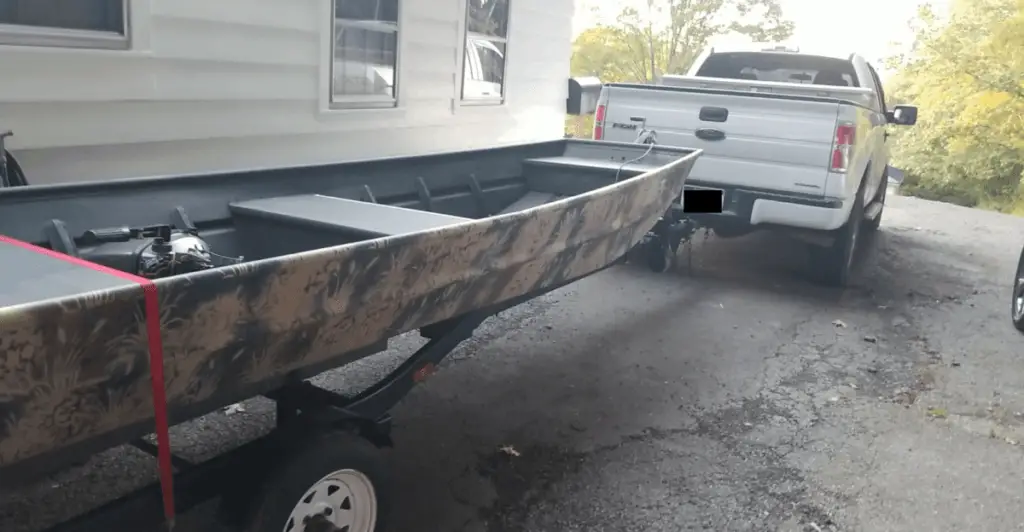
Boat aficionados everywhere have their own water vehicle preferences, but I want to focus on two in particular: Kayaks and Jon Boats. The two are very similar, but each comes with their own unique qualities. This can make choosing between them quite a task. I own both a fishing kayak and a Jon Boat so I feel that I can accurately break down the differences between the two and help you decide which is best for you.
So, should you use a kayak or a Jon boat? This decision mostly depends on what you want to do and where you want to do it. Kayaks are better if you’ll be by yourself in a smaller body of water. They’re also easier to steer than Jon boats. However, if you plan on going out with friends or you need more space for gear, a Jon boat is more practical.
There are, of course, other things to take into consideration before choosing which one will work best for you. Your budget, experience level, and customizability, among other things, are all important factors in solidifying your decision.
The Difference Between Kayaks and Jon Boats
The most notable difference between the two is their physical appearance. Kayaks are much slimmer and are made to fit one or two people. Kayaks are also usually only one of two sizes depending on if you’re looking at a single or a double. However, while Jon boats only have two basic styles, there are several different kayak styles to choose from.
Key Differences
Jon boats normally come with motors, so you’ll need at least some basic boating experience to successfully navigate one. Don’t let this turn you off to the idea of getting a Jon boat though, it’s easy to pick up on. Some states, like my state of West Virginia, also require that you get a boater’s license before you can legally use the gasoline motor on your Jon boat. Luckily most states offer this class online and for pretty cheap. Some states like Wyoming have no such law. Check to see if your state requires you to get a license.

Price
If budget is a big deal for you, kayaks will generally cost less than Jon boats. Most kayaks run around 10 feet and don’t really need any modifications, so their pricing is pretty set at roughly $400-$600 (keep in mind that this is entry-level and very cheap models a quality kayak will start at about $1000). Jon boats will normally run anywhere between $550-$700 before adding any modifications like motors, which is where the money is when it comes to boating.
Scroll to the bottom of the page for a chart that better illustrates the different types of kayaks and Jon boats and what you can expect to pay for them.
The cost doesn’t end with a purchase, which is easy to overlook. In terms of upkeep, you have to have somewhere to store the kayak and the boat. The kayak has to be stored indoors while the Jon boat (aside from the engine) can be stored outside, covered or uncovered. Another thing to consider is the price of the trailer required to tow the Jon boat along with the registration, property taxes, and fuel for the motor. You will also need a license to operate the boat depending on your state.
Put simply, the Jon boat is technically a never-ending expense in these terms.
Repairs
Another major difference between the two is that kayaks are much easier to repair than Jon boats are. With kayaks, you can usually patch up cracks and holes with a plastic patch and welding. However, with Jon boats, you can weld the broken parts back together, but it requires a bit more experience to get it right. Keep in mind that Jon boats are aluminum and are quite difficult to damage under normal circumstances.
I wrote an article about repairing all kinds of damage on a kayak and how to keep it in good condition. You can read that here.
Customization
If you want to be able to customize your vessel, Jon boats are better in this case. While kayaks can have coolers or drink holders attached to them, Jon boats have much more flexibility. You can literally spray paint your Jon boat when it needs a new coat of paint, these things are built for abuse while kayaks require a little more care.
In terms of added accessories, both kayaks and Jon boats have a HUGE aftermarket part selection and a thriving DIY community. If you can think of a modification for either vessel, I can almost guarantee there is a tutorial for it out there somewhere.
For the complete run-down of all the gear that I use and recommend, visit my Recommended Gear Page.
Comfort
In terms of comfort, kayaks tend to have a more contour-friendly design but cheap kayaks will always be less comfortable than the high-end models that I recommend. Sit-on-top kayaks come with a seat that is normally pretty comfortable and can be upgraded easily.
Jon boats normally have bench seating and can prove to be uncomfortable unless you buy something to add cushion, I purchased two swivel seats for my boat. These seats are comfortable but require you to sacrifice some stability but I didn’t notice a huge difference in my case. I got the seats and the mount off of Amazon if you’re curious about which seats I chose.
Speed
For those of you who have a need for speed, a Jon boat is better. Both Jon boats and kayaks can be equipped with motors but then you’re required to register the kayak as a boat so you’re better off to actually get the boat.
Kayaks rely solely on arm power to move while Jon boats don’t. However, kayaks have a leg up in the maintenance department. Because Jon boats use an engine, you need to make sure it’s properly taken care of whereas with a kayak you just need to wipe down the paddles every so often.
Transportation
For the most part, kayaks are easy enough to transport if you own a truck. Some solo kayakers still opt to use a pull-behind trailer because it is easier but isn’t required.
A pull-behind is required for a Jon boat, which requires a registration itself. Learning how to drive and back-up a trailer can be a challenge if you’ve never done it before.
Types of Kayaks
While kayaks are generally the same shape, there are actually several different styles available to you. Let’s take a quick look at each kind.
- Inflatable kayaks: This is more of a material rather than a type. Inflatable kayaks are generally less expensive than hard-material ones. You may also find some of the below styles in an inflatable option. Inflatables gather their appeal from kayakers who lack room to store a plastic kayak.
- Recreational kayaks: These are best for calm, flat waters. They’re made to be easy to get in and out of and are another generally affordable option. Cheaply made, put simply. I recommend avoiding these altogether if you’re serious about kayak fishing.
- Touring/Sea kayaks: These kayaks are best for trekking longer distances. They also have special equipment to help fight against wind and strong currents too. You’ll typically find extra cargo space with this one, and it will likely be at the higher end of the budget.
- Tandem kayaks: You’ll be able to find tandem kayaks in just about any style. The only difference this one has from others is that it’s meant for two people rather than a single person.
- Pedal-powered kayaks: Pedal-powered kayaks are probably going to be the most expensive options you’ll see. Rather than using oars, you use the pedals to move the kayak through the water. The perfect option for fishing.

Types of Jon Boats
Unlike kayaks, Jon boats come in two basic types: flat-bottomed or modified-v hull. While they’re of different design, most modern Jon boats are made of aluminum regardless of design. Aside from aluminum, you may find some that are made of wood or fiberglass too.
It’s most common that you’ll find Jon boats ranging from 10-21 feet in length. Most will come with just the standard boat shell, and you’ll have to buy modifiers like coolers or motors separately.
Flat-Bottomed
The flat-bottomed Jon boat is just as it sounds. The bottom of the boat is flat and wide on the bottom and resembles a rectangular shape. This type is ideal for calm water and mild weather. The flat design on the hull makes this one great for keeping stable as it distributes weight evenly across the bottom.
Because the draft of the boat is so shallow, it also makes this one ideal for traveling extremely shallow waters that other boats can’t reach. This trait makes flat-bottomed boats popular amongst duck hunters.
Keep in mind, with this one that you wouldn’t fare well in choppy waters. The design of the flat-bottom makes it difficult to flip the boat in case you capsize during rough weather.
This is the type of Jon boat I own. I chose this style strictly for the stability it offers and allows me to move around the boat freely.

Modified-V Hull
The modified-v hull, also known as the semi-V, can handle rough waters much better. This one has the same design as a basic Jon bat, except the angular bottom gives it more stability when the water gets choppy.
In a way, the modified-v is opposites with the flat-bottomed model. While flat-bottom Jon boats are good for calm waters, the modified-v doesn’t do well because its bottom is more curved. You also won’t have access to really shallow areas with a modified-v because the draft of the boat is much deeper than the latter.
You may also hear this type of hull being called a warped plane. The modified-v is one of the most popular hull designs and contributes to a boat’s speed as well as its rough water stability.
Cost Comparisons of Kayaks and Jon Boats
Because a budget is a large deciding factor for most people, let’s take a look at the cost comparisons between both vessels. Because there are varieties in size and material, cost varies from boat to boat.
Kayak Cost Comparison
| Type of Kayak | Typical Cost |
| Inflatable material | ~ $200 |
| Sea | $1,000 – $3,000 |
| Recreational | $250 – $600 |
| Touring | $500 – $1,000 |
| Tandem | $500 – $1,000 |
| Fishing | $1000 – $3000 |
| Pedal-Powered | $2,000 – $6,500 |
Jon Boat Cost Comparison
| Jon Boat Size | Typical Cost |
| 10 feet | $700-$800 |
| 11-13 feet | $850-$1,000 |
| 13-14 feet | $1,500-$2,250 |
| 15-16 feet | $2,500-$3,250 |
| 17+ feet | ~ $3,800 |
So Which is Better?
To answer this question simply, neither. That’s why I own both of them. Kayaks and Jon boats have their own advantages and disadvantages depending on what situation you’re in. I hope that this article helped guide you in the right direction.

